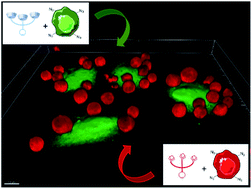Cell–cell interactions via non-covalent click chemistry†
Abstract
Metabolic glycoengineering with unnatural sugars became a valuable tool for introducing recognition markers on the cell membranes via bioorthogonal chemistry. By using this strategy, we functionalized the surface of tumor and T cells using complementary artificial markers based on both β-cyclodextrins (β-CDs) and adamantyl trimers, respectively. Once tied on cell surfaces, the artificial markers induced cell–cell adhesion through non-covalent click chemistry. These unnatural interactions between A459 lung tumor cells and Jurkat T cells triggered the activation of natural killer (NK) cells thanks to the increased production of interleukin-2 (IL-2) in the vicinity of cancer cells, leading ultimately to their cytolysis. The ready-to-use surface markers designed in this study can be easily inserted on the membrane of a wide range of cells previously submitted to metabolic glycoengineering, thereby offering a simple way to investigate and manipulate intercellular interactions.



 Please wait while we load your content...
Please wait while we load your content...